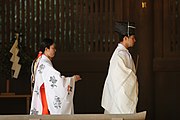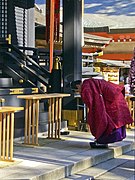|
Kannushi
Kannushi (神主, "divine master (of ceremonies)", originally pronounced kamunushi), also called shinshoku (神職, meaning "employee/worker of kami"), is the common term for a member of the clergy at a Shinto shrine (神社, jinja) responsible for maintaining the shrine and leading worship of the kami there.[1] The characters for kannushi are sometimes also read as jinshu with the same meaning. Kannushi originally referred only to the highest-ranking member of the clergy at a shrine, but has since expanded to become a collective term for all members of the clergy, synonymous with shinshoku. Another term shinkan (神官, lit. "religious official") used to exist, but the position was abolished during the removal of Shinto from government oversight during the establishment of the Japanese constitution.[2] HistoryOriginally, the kannushi were intermediaries between kami and people and could transmit their will to common humans.[3] A kannushi was a man capable of miracles or a holy man who, because of his practice of purificatory rites, was able to work as a medium for a kami. Later the term evolved to being synonymous with shinshoku - a man who works at a shrine and holds religious ceremonies there.[1][4] In ancient times, because of the overlap of political and religious power within a clan, it was the head of the clan who led the clansmen during religious functions, or else it could be another official.[4] Later, the role evolved into a separate and more specialized form. The term appears in both the Kojiki (680 AD) and Nihon Shoki (720 AD),[4] where the Empress Jingū and Emperor Sujin respectively become kannushi.[3] DescriptionWithin the same shrine, such as at Ise Jingū or Ōmiwa Shrine, there can be different types of kannushi at the same time; these may be called, for example, Ō-kannushi (大神主), Sō-kannushi (総神主), or Gon-kannushi (権神主).[3][4] Kannushi are assisted in their religious or clerical work by women called miko. Kannushi can marry, and their children usually inherit their position.[5] Although this hereditary status is no longer legally granted, it continues in practice.[6] Vestments and ritual objectsThe clothes kannushi wear, such as the jōe, the eboshi and kariginu, do not have any special religious significance, but are simply official garments previously used by the Imperial court.[5] This detail reveals the close connection between kami worship and the figure of the Emperor.[5] Other implements used by kannushi include a baton called shaku and a wand decorated with white paper streamers (shide) called ōnusa.
EducationTo become a kannushi, a novice must study at a university approved by the Association of Shinto Shrines (神社本庁, Jinja Honchō), typically Tokyo's Kokugakuin University or Ise's Kogakkan University, or pass an exam that will certify his qualification.[6] Women can also become kannushi, and widows can succeed their husbands in their job.[6] Hierarchy, rank, and statusShinto clergy are given a rank (階位, kaii) and placed within a hierarchy (職階, shokkai) at their shrine which results in varying levels of relative status, though the relative importance of the shrine they work at has no affect on their status. For example, the head priest of a beppyo shrine is of equal status to a head priest of a small regional shrine. Additionally, rank and hierarchy are not the same, with hierarchy more important for determining status than rank. For example, a head priest of only seikai rank would be higher in status than an assistant priest of the meikai rank. RanksThe Association of Shinto Shrines has regulations that confer one of five ranks called kaii (階位) on clergy members based on their level of education and passing of exams. Up to the second highest rank, meikai (明階), can be reached through study alone. The names of the ranks come from the four virtues of Shinto: purity (浄, jō), light (明, mei), correctness (正, sei), and forthrightness (直, choku). There were originally only four ranks until 1961 when the ranks were reformed and the fourth rank of gonsekai (権正階) was added.[7] Jōkai (浄階): The highest rank. Given to those with a long history of contributions to Shinto research. Meikai (明階): The rank necessary to become a head priest or assistant head priest at a beppyo shrine. A clergy member with this rank can take a head priest position at any shrine other than Ise Shrine's high head priest position which requires imperial sanction. Seikai (正階): The rank necessary to become an assistant priest or interim head priest (宮司代務者, gūji daimusha) at a beppyo shrine. Gonsekai (権正階): The rank necessary to become a head priest or interim head priest at a standard shrine, or a junior priest at a beppyo shrine. Chokkai (直階): The rank necessary to become an assistant priest or junior priest at a standard shrine. HierarchyThe clergy of a shrine is ranked in a heirarchy called shokkai (職階). The exact heirarchy may vary based on the scale and history of the shrine but, in general, the heirarchy from highest ranking to lowest is head priest (宮司, gūji), assistant priest (禰宜, negi), and junior priest (権禰宜, gonnegi). There is generally only one head priest and one assistant priest per shrine. Some beppyo shrines have an assistant head priest (権宮司, gongūji) role ranking below the head priest and several assistant priests. An overview of their roles is that the head priest is the head of the shrine, the assistant head priest is the secondary leader, the assistant priest(s) support the head priest in their duties, and the junior priests perform general tasks. Ise Shrine is an exception in that its ranks are as follows: master of ceremonies (祭主, saishu), high head priest (大宮司, daigūji), low head priest (少宮司, shōgūji), assistant priest (negi), junior priest (gonnegi), shrine administrator (宮掌, gūshō), attendant (出仕, shusshi), and apprentice attendant (出仕前, shusshi-mae).[8] Other positionsOnshiOnshi (御師, also read oshi) is a low-ranking position at a shrine responsible for leading prayers for visitors, providing lodging and tours for pilgrims, and arranging performances of kagura. They are most associated with Ise Shrine.[9] Lower priestsThere are two positions that may be called lower priests, gūshō (宮掌) and shuten (主典), though they are not technically considered members of the clergy as they have not yet received their rank (kaii) and are only present in some special shrines, such as Ise Shrine and Atsuta Shrine. They perform some duties under the guidance of higher-ranking priests.[10] See alsoReferences
External linksWikimedia Commons has media related to kannushi.
|



